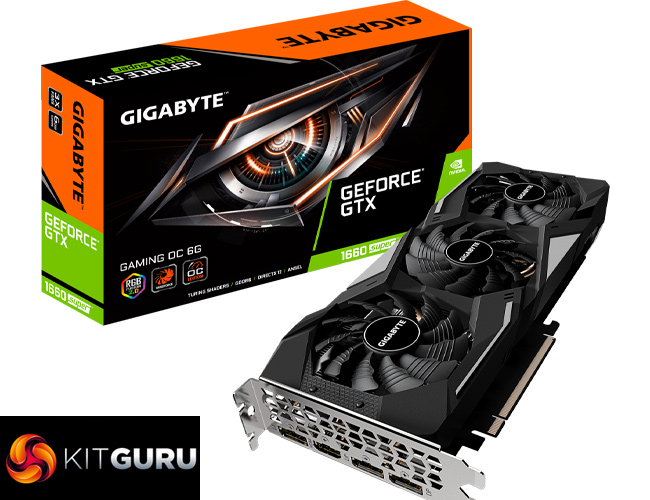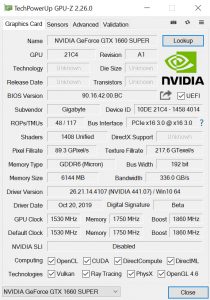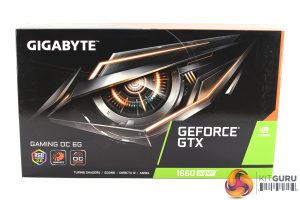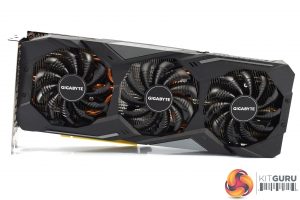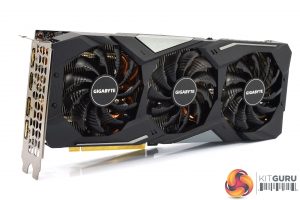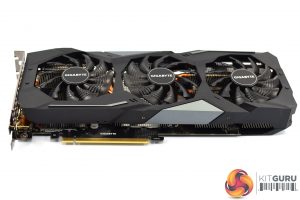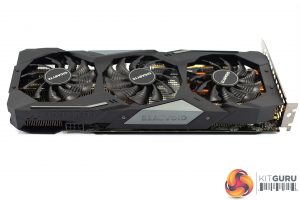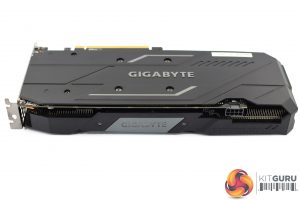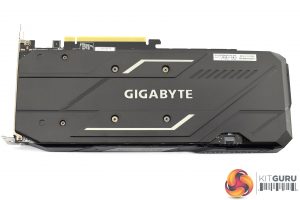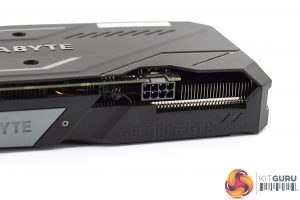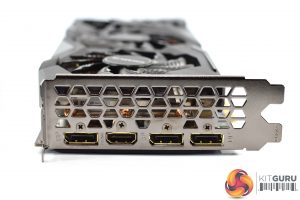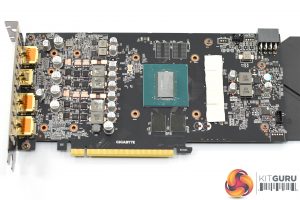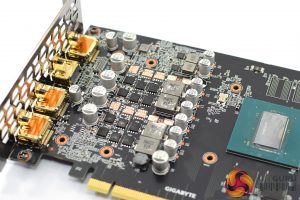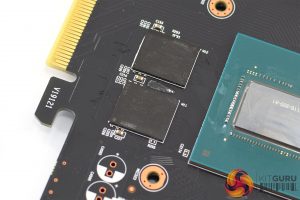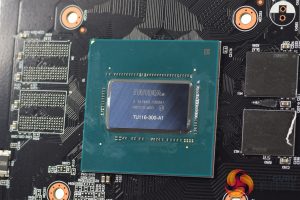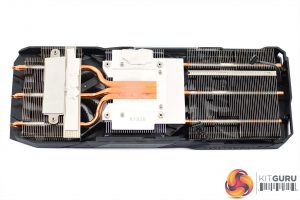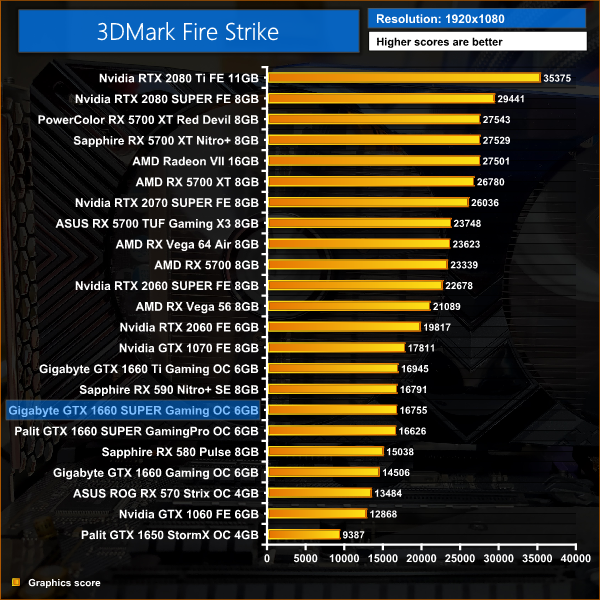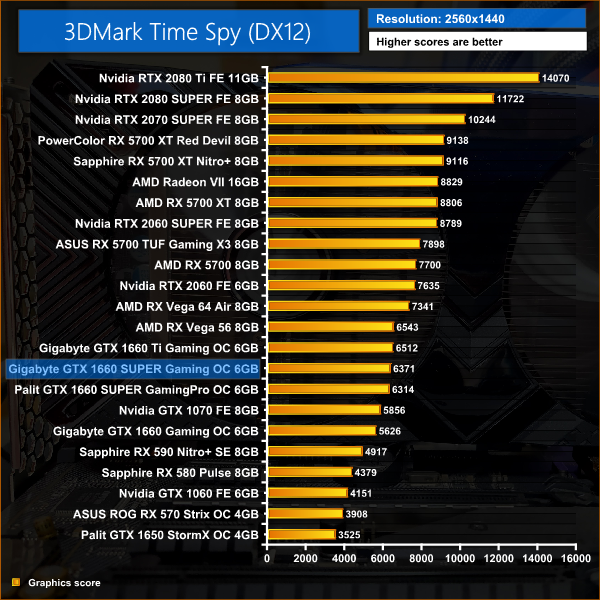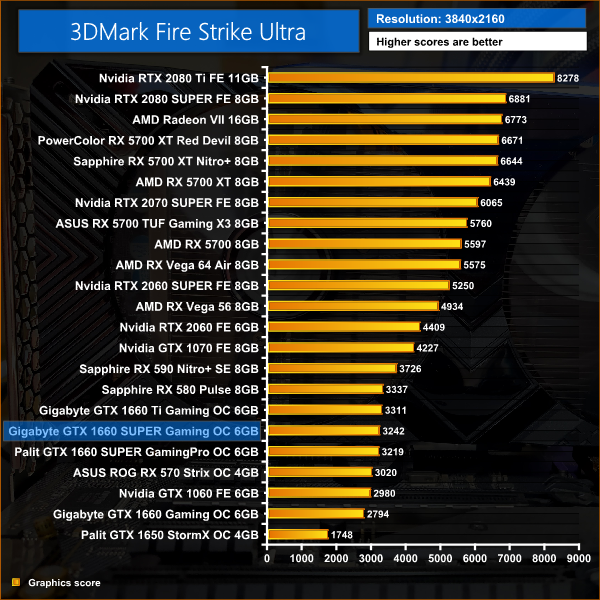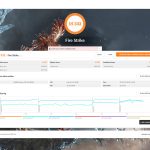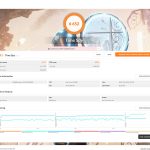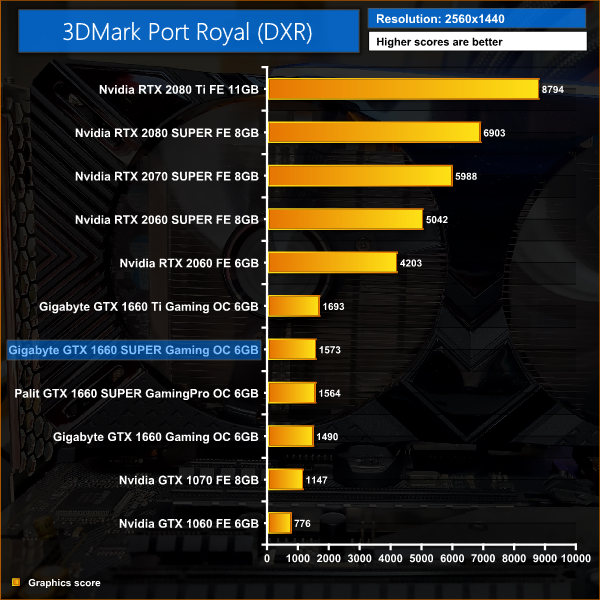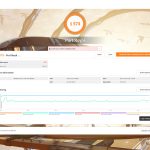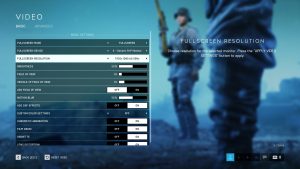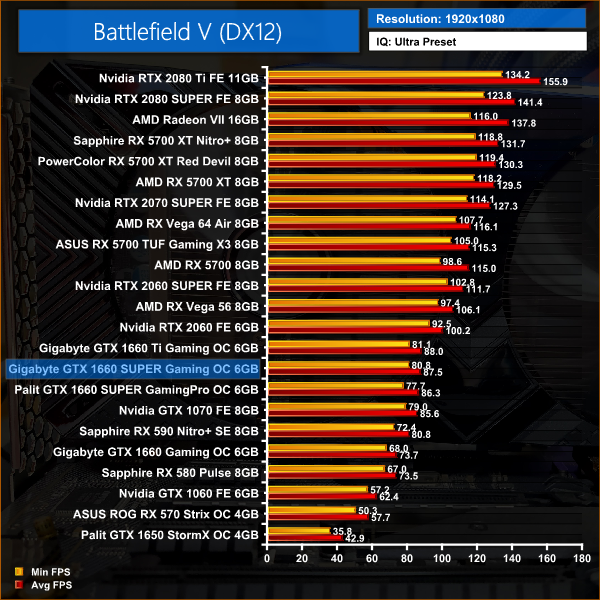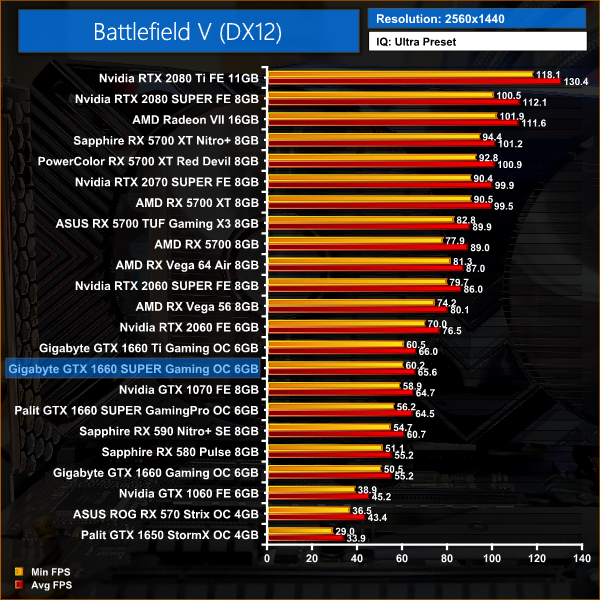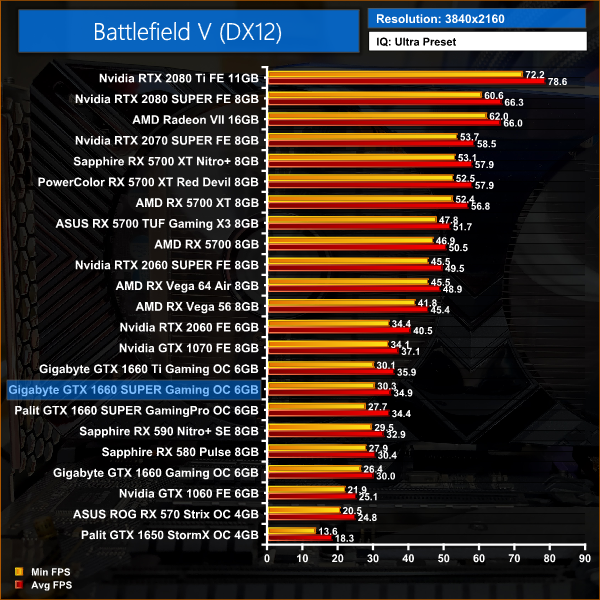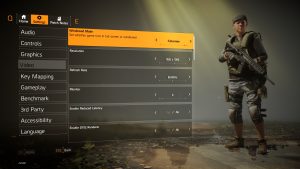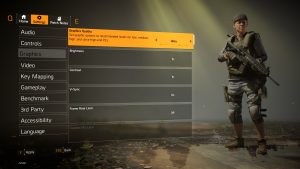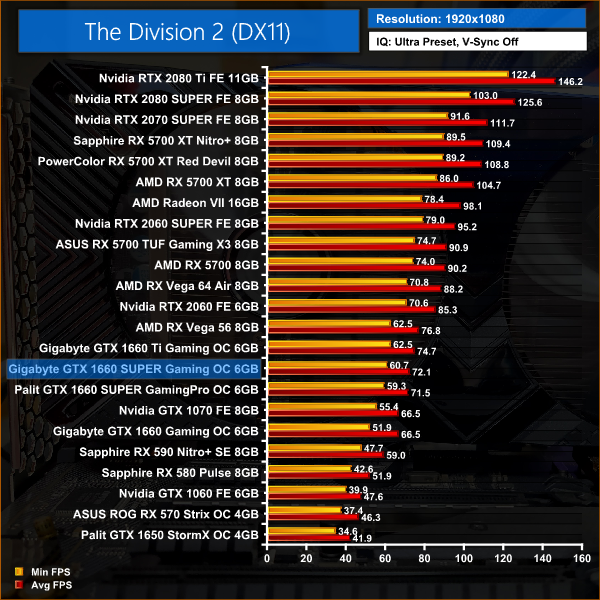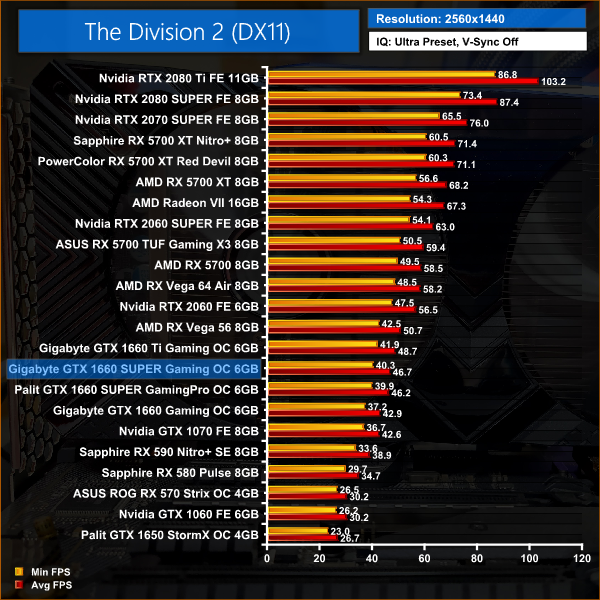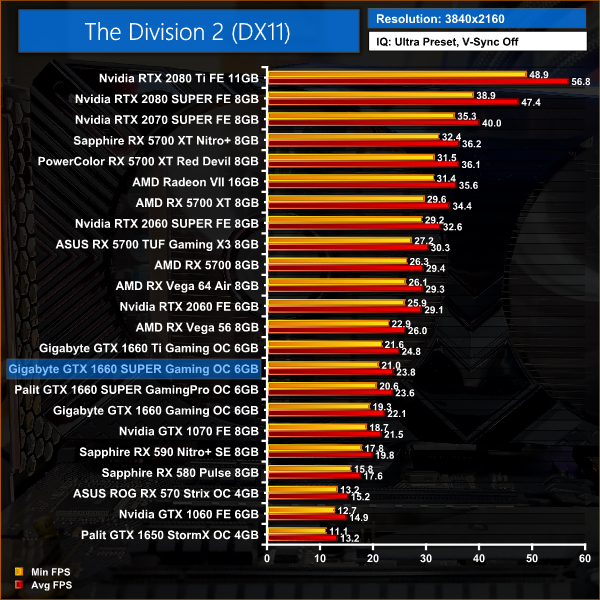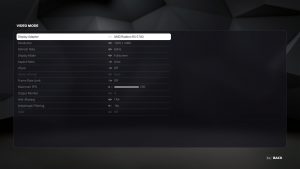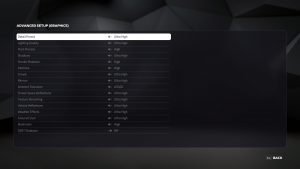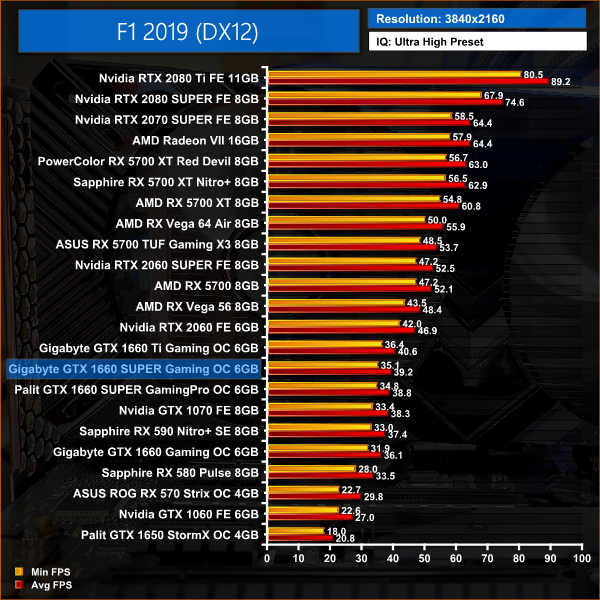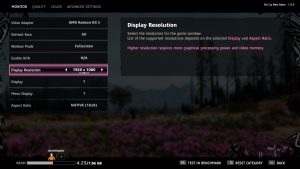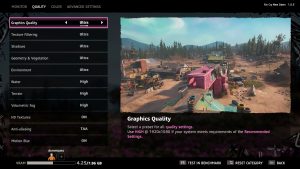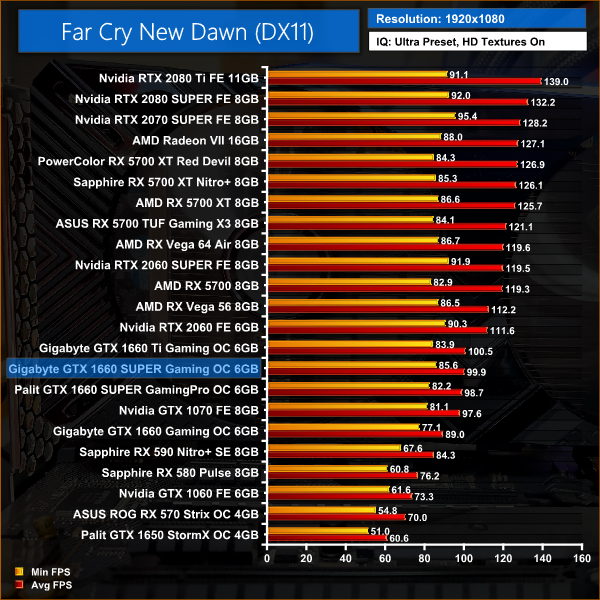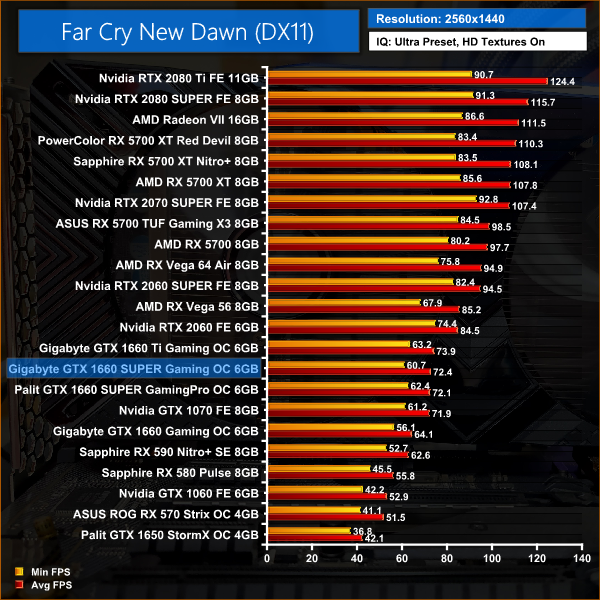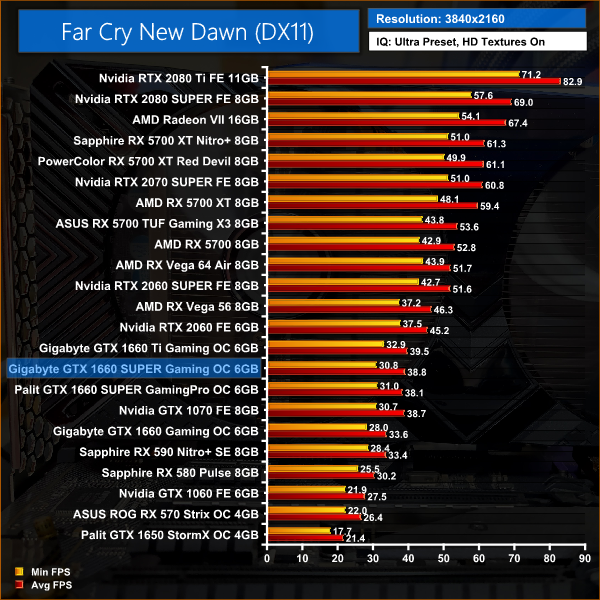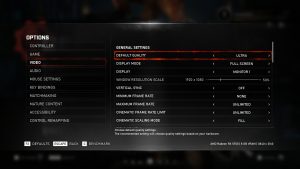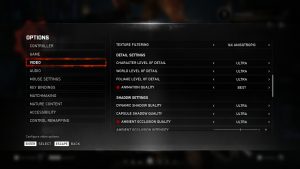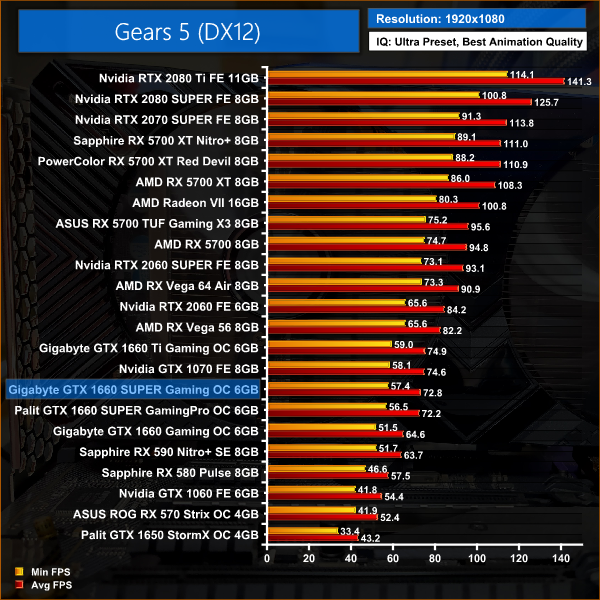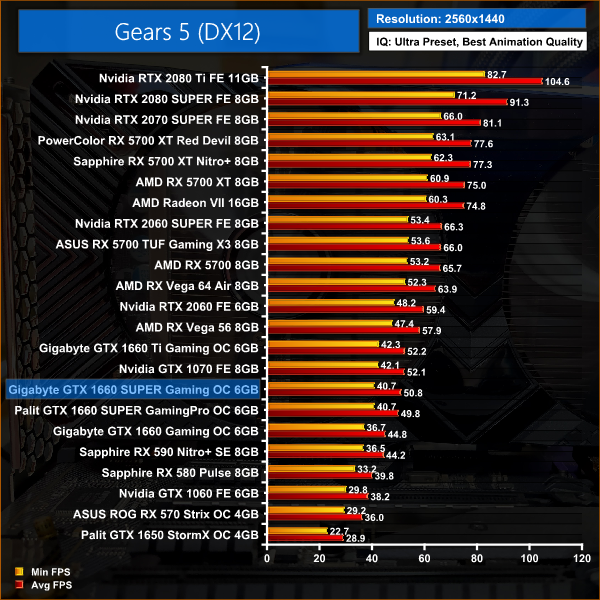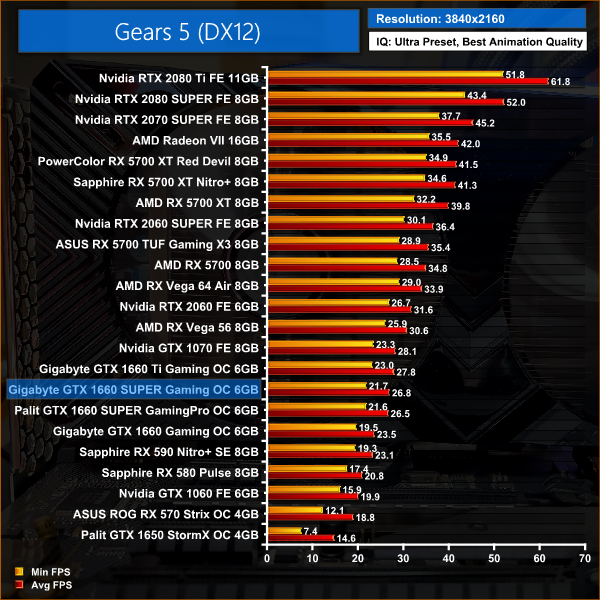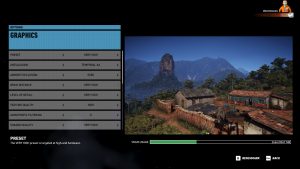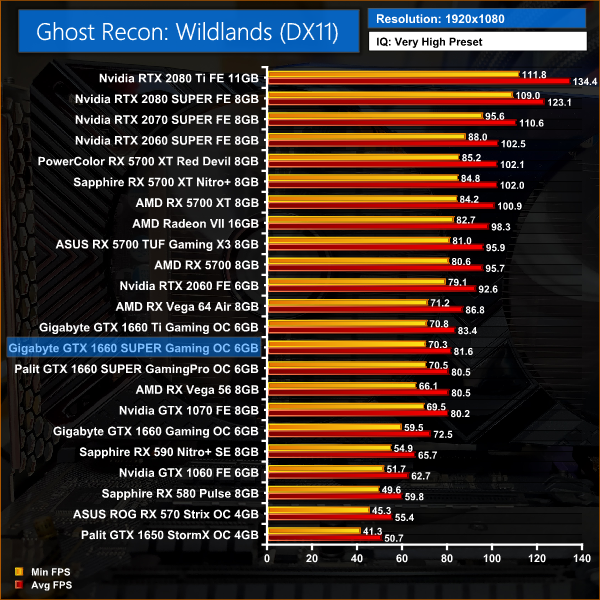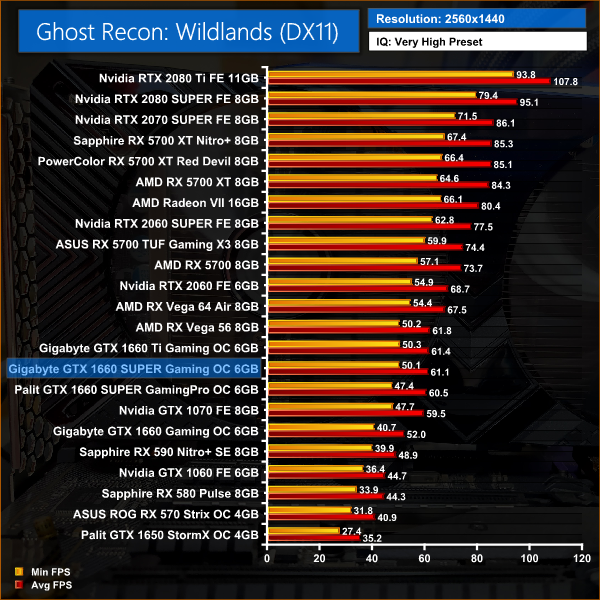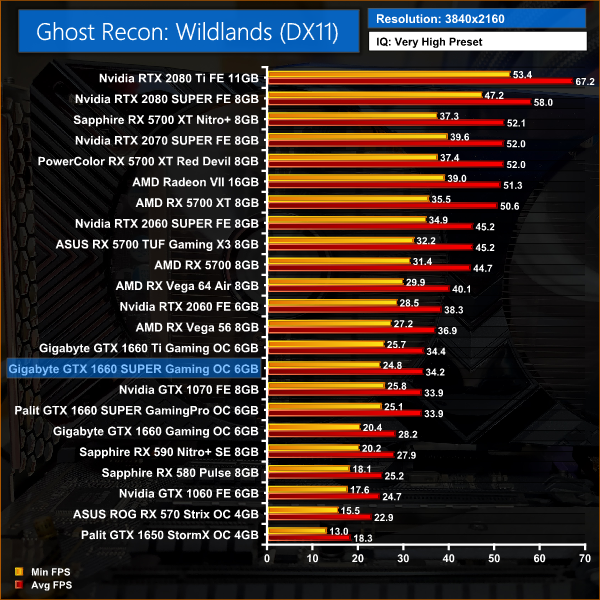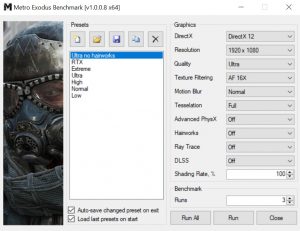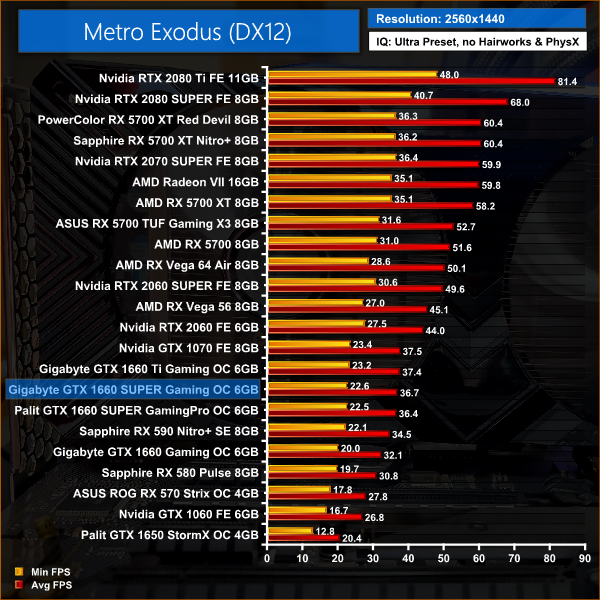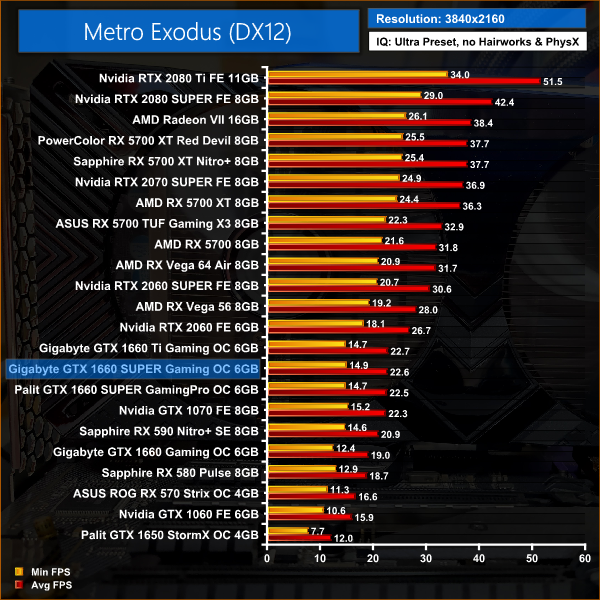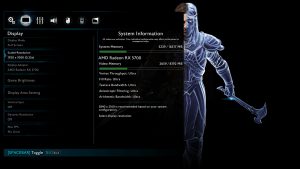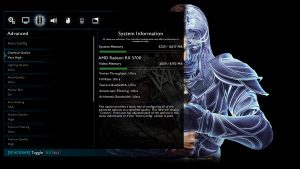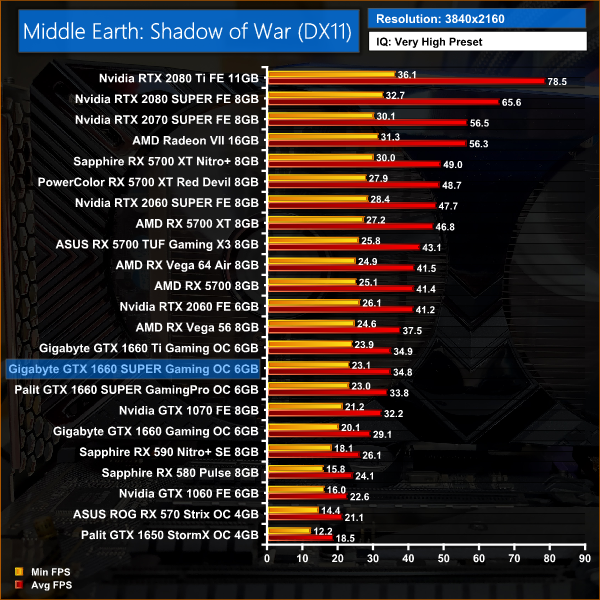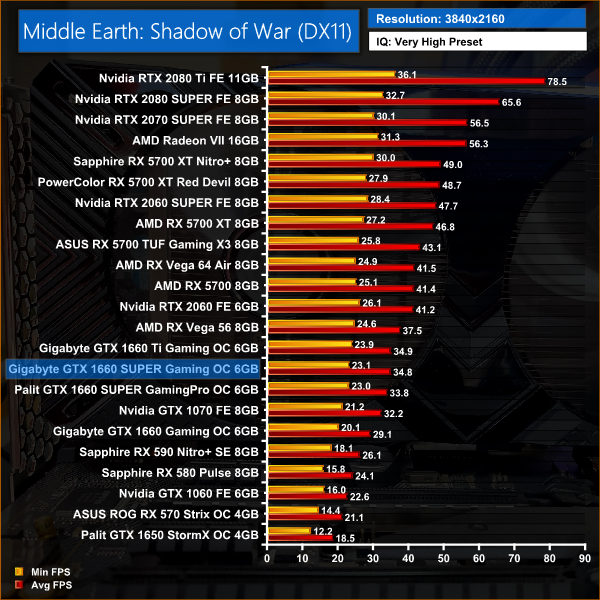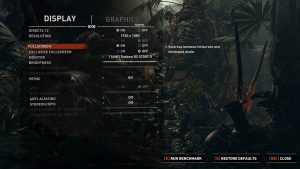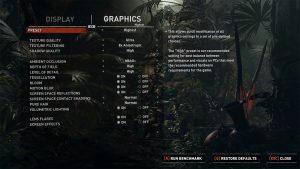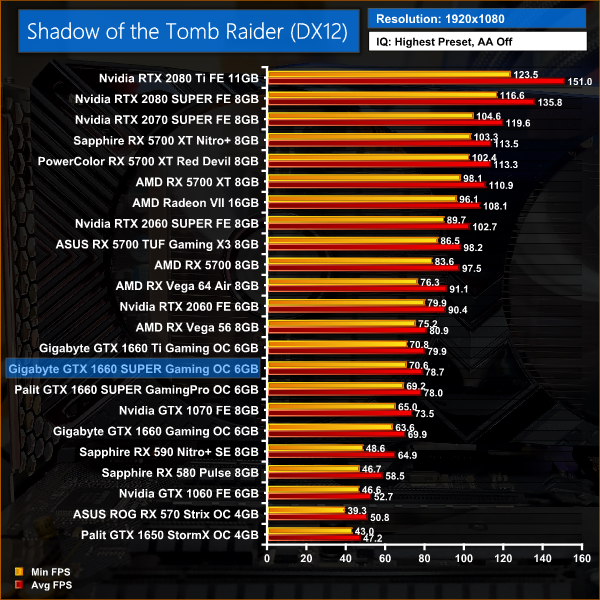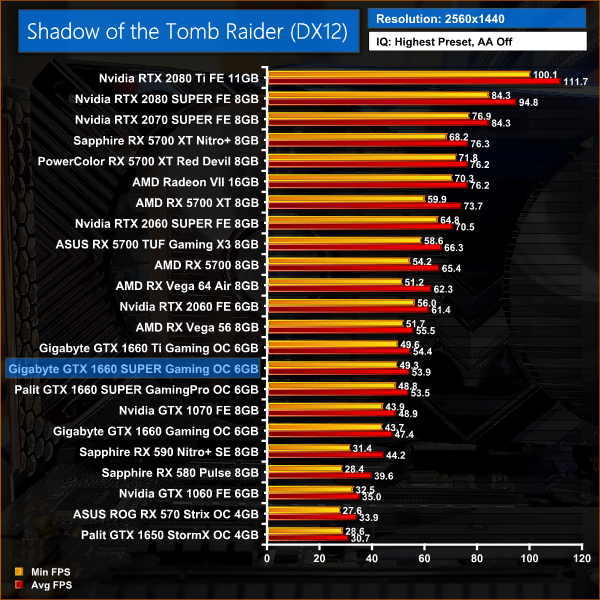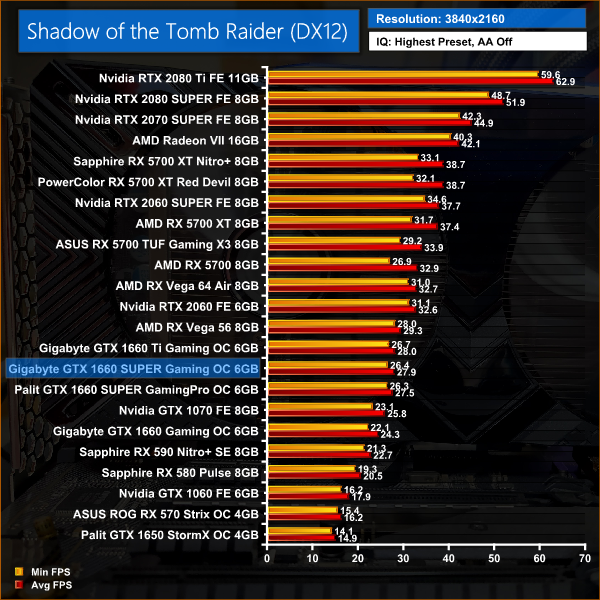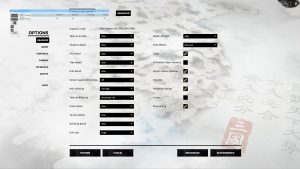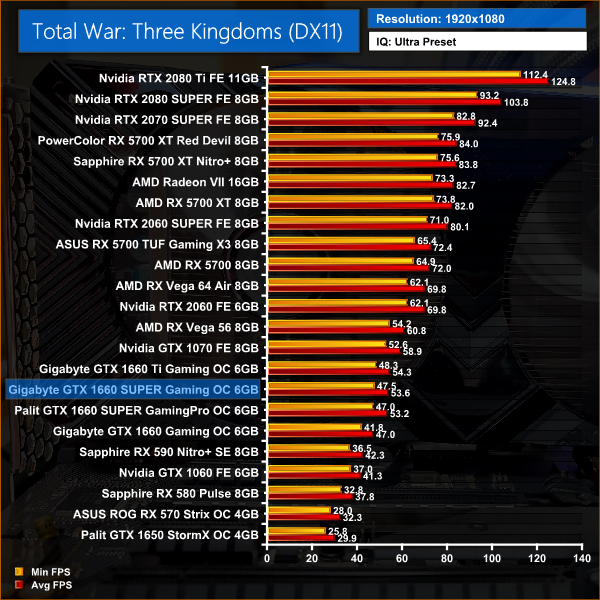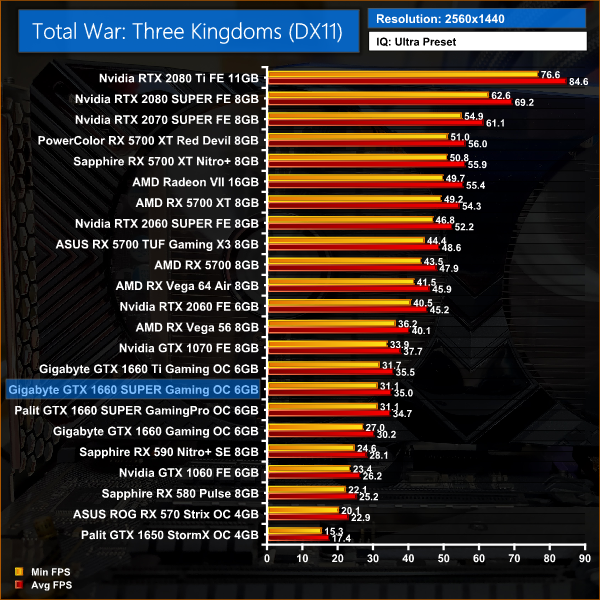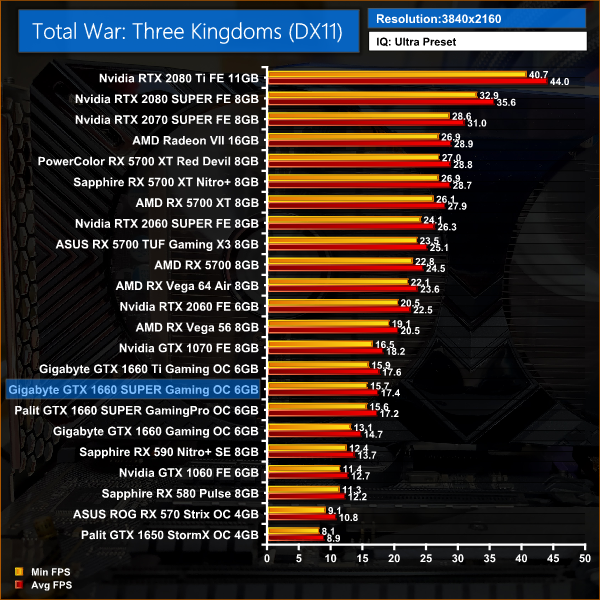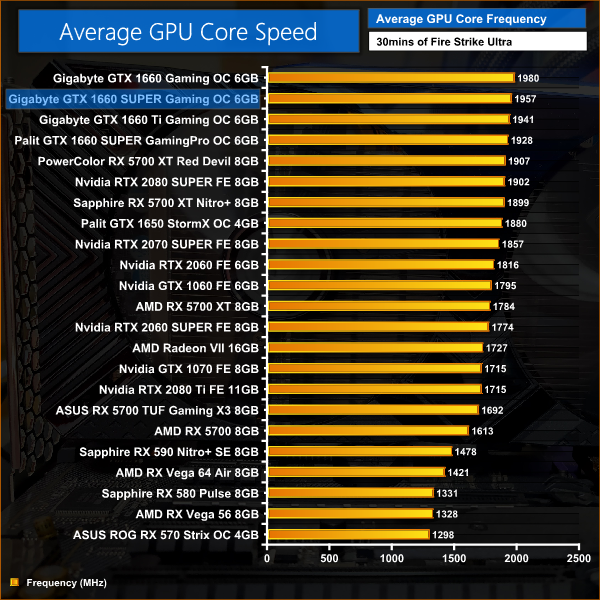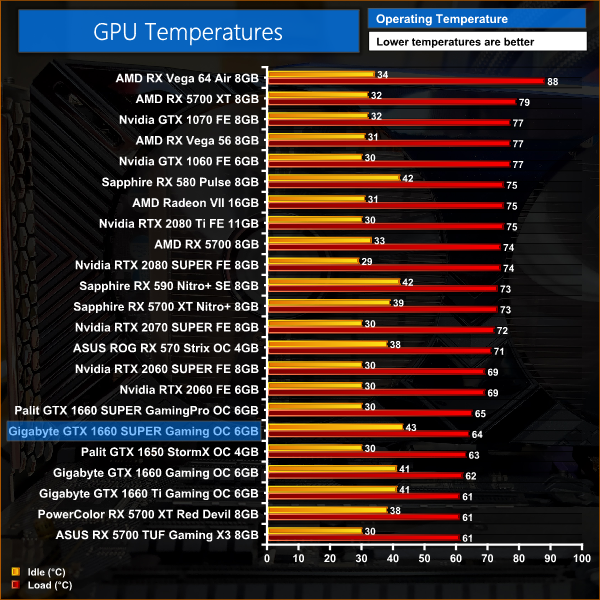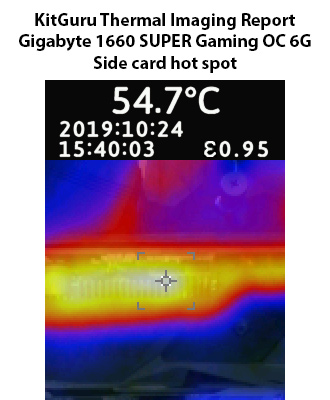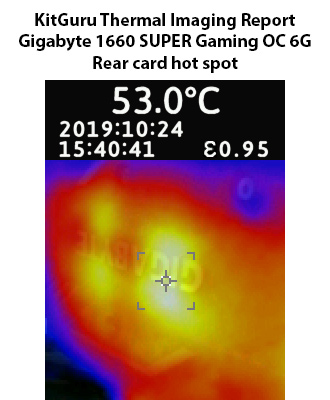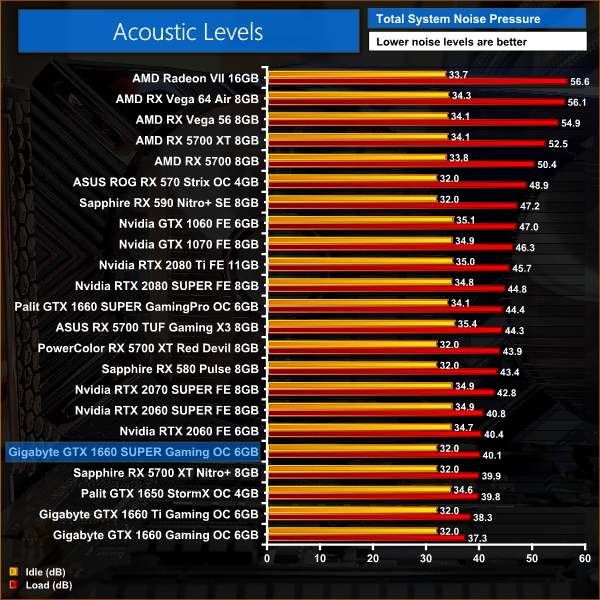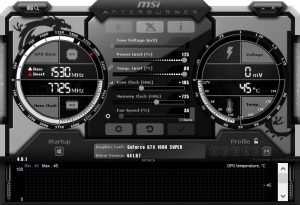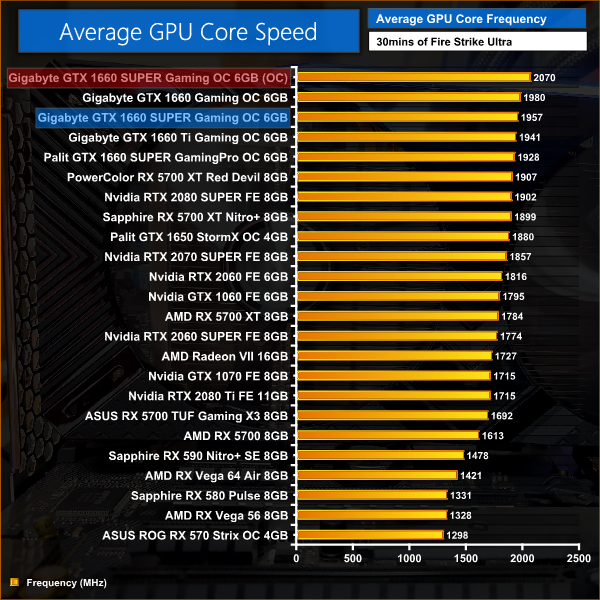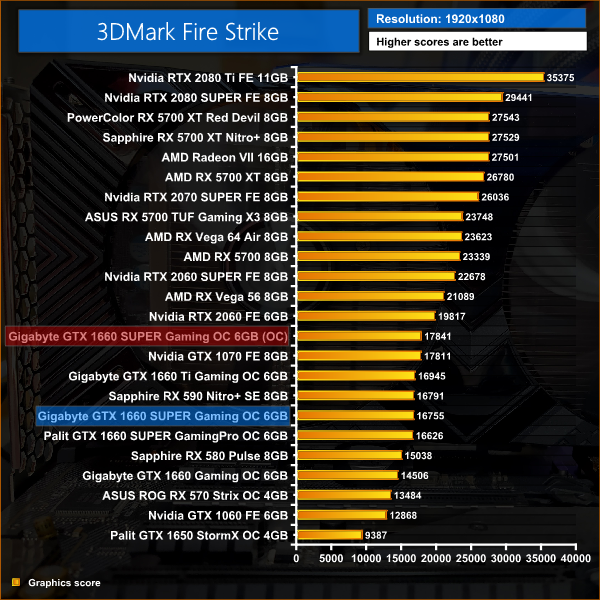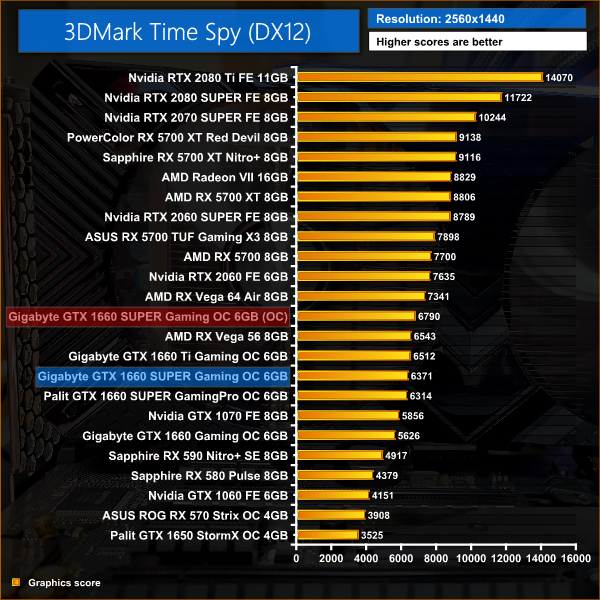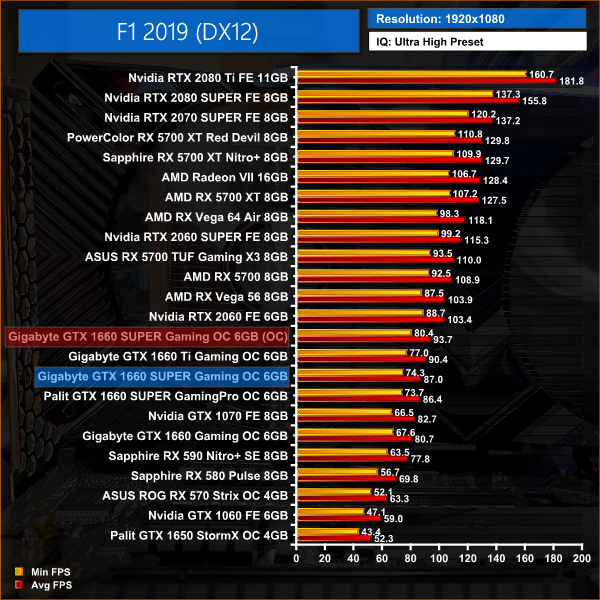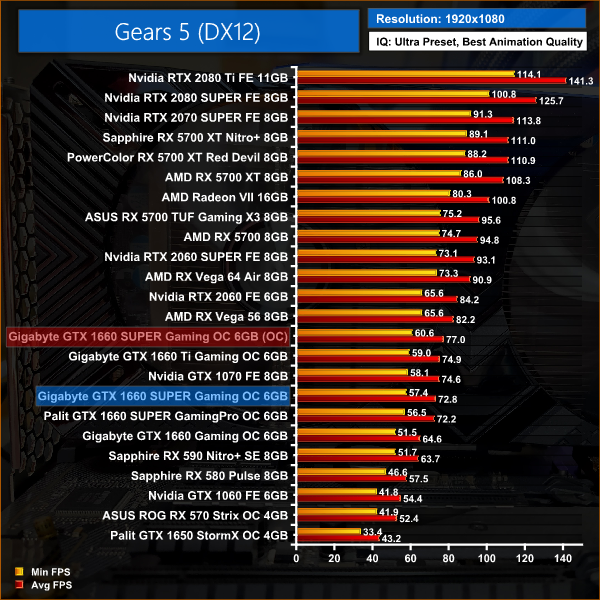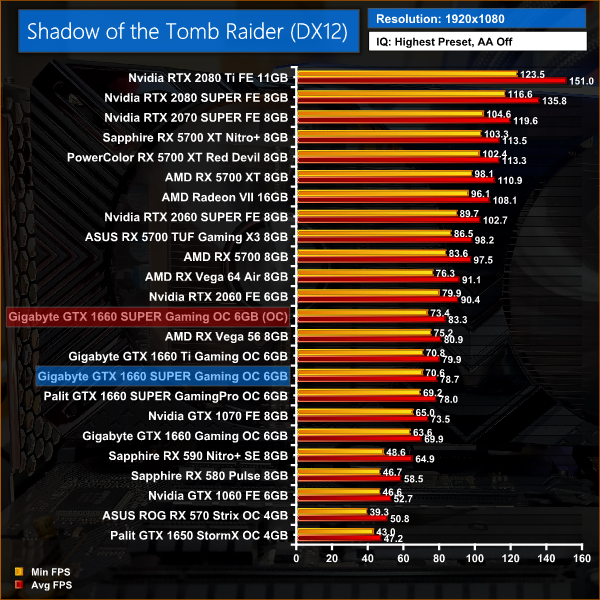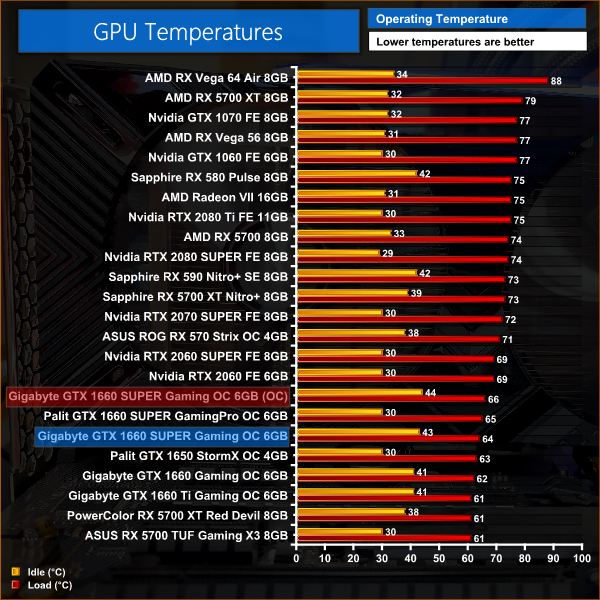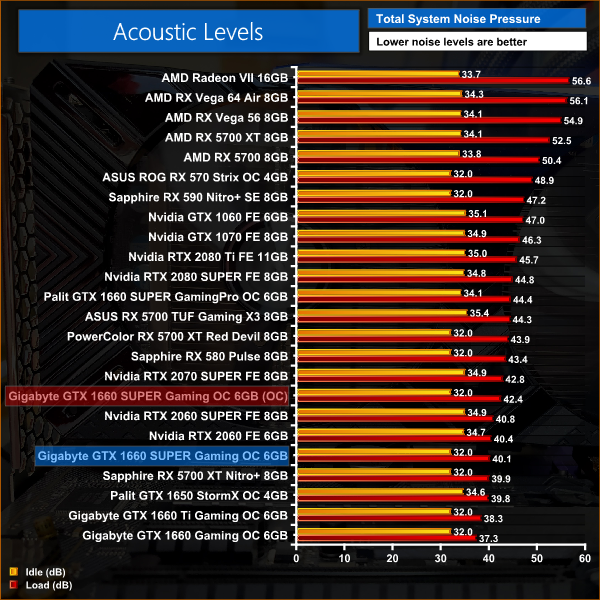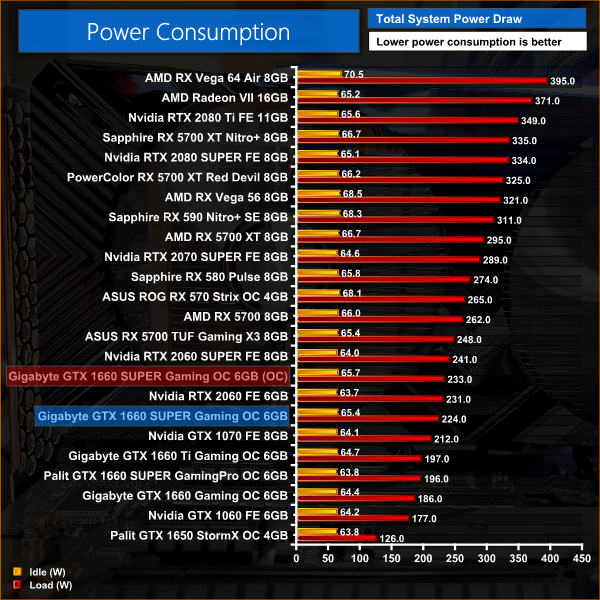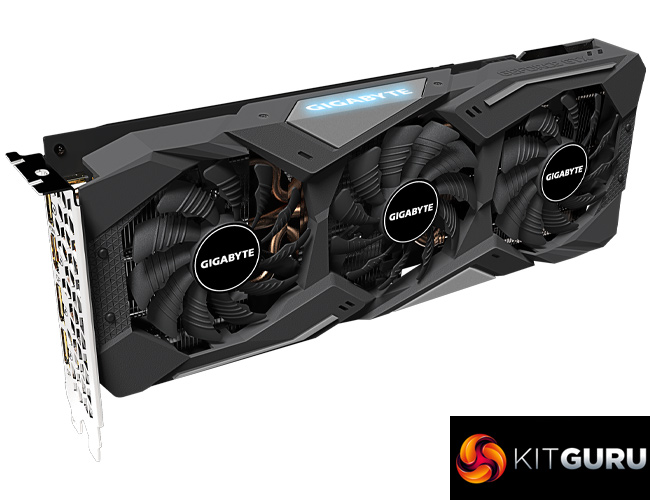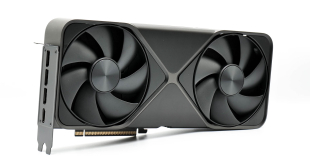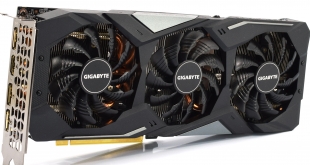
We've heard a lot about the GTX 1660 SUPER over the last few weeks, and today the new graphics card from Nvidia has been officially announced. For launch we have two partner card reviews, but this is focused on the Gigabyte GTX 1660 SUPER Gaming OC 6G – a triple-fan, factory overclocked card that promises low temperatures and high frame rates. Is it – and 1660 SUPER as a whole – any good?
If you've been living under a rock for the last few weeks, it is very easy to summarise what Nvidia has done with the GTX 1660 SUPER – take a vanilla GTX 1660, swap out the slower GDDR5 memory for improved GDDR6 modules, and you have a GTX 1660 SUPER.
That means the TU116 GPU at the heart of the GTX 1660 is entirely unchanged – it's the same Turing architecture, it still sports 22 SMs and 1408 CUDA Cores, and there's still no RT or Tensor cores as per the RTX 20-series cards. It's purely the upgrade to G6 memory from G5 which makes this a ‘SUPER' card.
I'd also like to just clarify where the 1660 SUPER sits in Nvidia's product stack, as it is now a very busy line-up. Put simply, GTX 1660 SUPER, with a £209.99 MSRP, slots in between GTX 1660 (£199) and GTX 1660 Ti (£259). Neither the GTX 1660 or GTX 1660 Ti are being phased out according to Nvidia, but while there will be no official price cut to the GTX 1660, Nvidia does expect prices to fall naturally as a result of 1660 SUPER entering the market.
| GPU | RTX 2060 (FE) | GTX 1660 Ti | GTX 1660 SUPER | GTX 1660 | GTX 1060 |
| SMs | 30 | 24 | 22 | 22 | 10 |
| CUDA Cores | 1920 | 1536 | 1408 | 1408 | 1280 |
| Tensor Cores | 240 | N/A | N/A | N/A | N/A |
| Tensor FLOPS | 51.6 | N/A | N/A | N/A | N/A |
| RT Cores | 30 | N/A | N/A | N/A | N/A |
| Texture Units | 120 | 96 | 88 | 88 | 80 |
| ROPs | 48 | 48 | 48 | 48 | 48 |
| Rays Cast | 5 Giga Rays/sec | – | – | – | 0.44 Giga Rays/sec |
| RTX Performance | 37 Trillion RTX-OPS | – | – | – | N/A |
| GPU Boost Clock | 1680 MHz | 1770 MHz | 1785 MHz | 1785 MHz | 1708 MHz |
| Memory Data Rate | 14 Gbps | 12 Gbps | 14 Gbps | 8 Gbps | 8 Gbps |
| Total Video Memory | 6GB GDDR6 | 6GB GDDR6 | 6GB GDDR6 | 6GB GDDR5 | 6GB GDDR5 |
| Memory Interface | 192-bit | 192-bit | 192-bit | 192-bit | 192-bit |
| Memory Bandwidth | 336.1 GB/sec | 288.1 GB/sec | 336 GB/sec | 192.1 GB/sec | 192 GB/sec |
| TGP | 160W | 120W | 125W | 120W | 120W |
We already mentioned how the only core change to the GTX 1660 is the upgraded 14Gbps GDDR6 memory, and that improves total memory bandwidth from 192.1GB/s to 336 GB/s.
Additionally, while there is no reference card per se, Nvidia did release ‘reference spec', so we can see that the Gigabyte Gaming OC 6G model for review here has been factory overclocked by 75MHz, up to 1860MHz boost.
Lastly, with what can only be a consequence of the change in memory, it is also worth noting that 1660 SUPER has a Total Graphics Power (TGP) rating of 125W, a 5W increase over the vanilla 1660.
The Gigabyte GTX 1660 SUPER Gaming OC 6G ships in a familiar-looking box, with a large robotic eye taking up most of the front – there's no image of the card itself here.
Inside, there's precious little in the way of accessories, with just a quick start guide and driver disk making up the bundle.
Moving onto the card itself, if it looks a bit familiar that's probably because it is – Gigabyte is reusing its existing GTX 1660 Ti Gaming OC design for this GTX 1660 SUPER. This makes perfect sense, but if you were expecting some new designs or aesthetic changes then you may be disappointed.
It's a triple-fan card, with three 80mm spinners, though you will note the middle fan actually spins in reverse to the outer two. This is part of Gigabyte's ‘Windforce 3X' design and should help reduce overall turbulence and thus increase airflow down onto the card itself.
As for the overall look of the Gaming OC 6G, I like it. It's quite simple and minimalist, with a mostly black plastic shroud, though there are some grey sections which add interest. By and large, though, it's an inoffensive design that is also very colour-neutral so you could slot this into pretty much any system and it wouldn't look out of place.
Despite being ‘just' two slots thick, the Gaming OC 6G isn't tiny – it measures 280 x 116.7 x 40.4 mm. That's a fairly long card, then, so do double-check if it will fit in your case before purchasing.
Elsewhere, we can see a single Gigabyte logo on the front of the card, and this is the sole RGB zone. We also get a look at the plastic backplate used here – it's not going to help with heat dissipation from the back of the PCB, but it does provide a little extra in the way of structural rigidity and will also help protect the card should an all-in-one liquid cooler start leaking.
As for power connectors, all 1660 SUPER cards require 1x 8-pin connector, so that's what we have here. Display outputs are variable, with Gigabyte opting for 3x DisplayPort and 1x HDMI.
As for the PCB, this is also identical to the GTX 1660 Ti Gaming OC 6G – as far as I can tell, at least. This means we have a 4+2 VRM solution, while we can also note the 6GB of GDDR6 memory from Micron – labelled ‘9OA77D9WCW'. As there have no changes to the GPU itself, this carries the same ‘TU116-300-A' labelling as the vanilla GTX 1660.
The cooler uses three separate fin stacks, and these are connected by 3x 6mm copper heatpipes. Instead of a contact plate, these pipes makes direct contact with the GPU die, but there are separate plates for the VRAM and VRM.
Our newest GPU test procedure has been built with the intention of benchmarking high-end graphics cards. We test at 1920×1080 (1080p), 2560×1440 (1440p), and 3840×2160 (4K UHD) resolutions.
We try to test using the DX12 API if titles offer support. This gives us an interpretation into the graphics card performance hierarchy in the present time and the near future, when DX12 becomes more prevalent. After all, graphics cards of this expense may stay in a gamer’s system for a number of product generations/years before being upgraded.
We tested the RX Vega64 and Vega56 using the ‘Turbo‘ power mode in AMD’s WattMan software. This prioritises all-out performance over power efficiency, noise output, and lower thermals.
Driver Notes
- All AMD graphics cards were benchmarked with the Adrenalin 19.9.2 driver.
- All Nvidia graphics cards (except 1660 SUPER) were benchmarked with the Nvidia 436.48 driver.
- All GTX 1660 SUPER graphics cards were benchmarked with the Nvidia 441.07 driver supplied to press ahead of launch.
Test System
We test using the Overclockers UK Germanium pre-built system, though it has been re-housed into an open-air test bench. You can read more about it over HERE.
| CPU |
Intel Core i7-8700K
Overclocked to 5.0GHz |
| Motherboard |
ASUS ROG Strix Z370-F Gaming
|
| Memory |
Team Group Dark Hawk RGB
16GB (2x8GB) @ 3200MHz 16-18-18-38 |
| Graphics Card |
Varies
|
| System Drive |
Samsung 960 EVO 500GB
|
| Games Drive | Kingston UV500 960GB |
| Chassis | Streacom ST-BC1 Bench |
| CPU Cooler |
OCUK TechLabs 240mm AIO
|
| Power Supply |
Corsair AX1500i 80+ Titanium PSU
|
| Operating System |
Windows 10 1903
|
Comparison Graphics Cards List
- Nvidia RTX 2080 Ti Founders Edition (FE) 11GB
- Nvidia RTX 2080 SUPER Founders Edition (FE) 8GB
- Nvidia RTX 2070 SUPER Founders Edition (FE) 8GB
- Nvidia RTX 2060 SUPER Founders Edition (FE) 8GB
- Nvidia RTX 2060 Founders Edition (FE) 6GB
- Gigabyte GTX 1660 Ti OC 6G
- Gigabyte GTX 1660 Gaming OC 6G
- Palit GTX 1650 StormX OC 4GB
- Nvidia GTX 1060 Founders Edition (FE) 6GB
- AMD RX 5700 XT 8GB
- PowerColor RX 5700 XT Red Devil 8GB
- Sapphire RX 5700 XT Nitro+ 8GB
- ASUS RX 5700 TUF Gaming X3 8GB
- AMD RX 5700 8GB
- AMD Radeon VII 16GB
- AMD RX Vega 64 Air 8GB
- AMD RX Vega 56 8GB
- Sapphire RX 590 Nitro+ SE 8GB
- Sapphire RX 580 Pulse 8GB
- ASUS RX 570 ROG Strix Gaming OC 4GB
Software and Games List
- 3DMark Fire Strike & Fire Strike Ultra (DX11 Synthetic)
- 3DMark Time Spy (DX12 Synthetic)
- 3DMark Port Royal (DXR Synthetic)
- Battlefield V (DX12)
- The Division 2 (DX11)
- F1 2019 (DX12)
- Far Cry New Dawn (DX11)
- Gears 5 (DX12)
- Ghost Recon: Wildlands (DX11)
- Metro: Exodus (DX12)
- Middle Earth: Shadow of War (DX11)
- Shadow of the Tomb Raider (DX12)
- Total War: Three Kingdoms (DX11)
We run each benchmark/game three times, and present averages in our graphs.3DMark Fire Strike is a showcase DirectX 11 benchmark designed for today’s high-performance gaming PCs. It is our [FutureMark’s] most ambitious and technical benchmark ever, featuring real-time graphics rendered with detail and complexity far beyond what is found in other benchmarks and games today.
It's an interesting start for the Gigabyte 1660 SUPER, performing essentially on-par with the GTX 1660 Ti – it's also 13% faster than the 1660 in Time Spy.
3DMark Port Royal is the world’s first dedicated real-time ray tracing benchmark for gamers. You can use Port Royal to test and compare the real-time ray tracing performance of any graphics card that supports Microsoft DirectX Raytracing. As well as benchmarking performance, 3DMark Port Royal provides a realistic and practical example of what to expect from ray tracing in upcoming games.
While there's no specific ray tracing hardware that forms part of the 1660 SUPER GPU, the card does support Microsoft's DXR API – so it can run 3DMark Port Royal. As you'd expect, the results aren't a scratch on the RTX 2060 – which has proper RT cores – but the new memory does help the card score above the 1660.
Battlefield V is a first-person shooter video game developed by EA DICE and published by Electronic Arts. Battlefield V is the sixteenth instalment in the Battlefield series. It was released worldwide for Microsoft Windows, PlayStation 4, and Xbox One on November 20, 2018. (Wikipedia).
We test using the Ultra preset, DX12 API.
Battlefield V follows on from our 3DMark results very neatly – Gigabyte's 1660 SUPER is on average 18% faster than the 1660 in this title, while proving no more than 3% slower versus the 1660 Ti.
Tom Clancy's The Division 2 is an online action role-playing video game developed by Massive Entertainment and published by Ubisoft. The sequel to Tom Clancy's The Division (2016), it is set in a near-future Washington, D.C. in the aftermath of a smallpox pandemic, and follows an agent of the Strategic Homeland Division as they try to rebuild the city. (Wikipedia).
We test using the Ultra preset, but with V-Sync disabled, DX11 API.
The Division 2 shows less of a gain for the 1660 SUPER, with Gigabyte's card proving 8% faster than the 1660, while it is also 4% slower than the 1660 Ti. Comparatively, the 1660 SUPER also does well up against Vega 56 here, where it's just 7% slower than the AMD card.
F1 2019 is a racing video game based on the 2019 Formula One and Formula 2 Championships. The game is developed and published by Codemasters and is the twelfth title in the Formula One series developed by the studio. The game was announced by Codemasters on 28 March 2019. (Wikipedia).
We test using the Ultra High preset, with TAA and 16x Anisotropic Filtering, DX12 API.
F1 2019 follows a very similar trend to The Division 2, with 1660 SUPER again 8% faster than 1660. It's very close to the 1660 Ti, but is still 4% slower on average.
Far Cry New Dawn is an action-adventure first-person shooter developed by Ubisoft Montreal and published by Ubisoft. The game is a spin-off of the Far Cry series and a narrative sequel to Far Cry 5. It was released for Microsoft Windows, PlayStation 4 and Xbox One on February 15, 2019. (Wikipedia).
We test using the Ultra preset, with the HD Textures pack, DX11 API.
Far Cry New Dawn stretches 1660 SUPER's lead to 14% over the 1660, and it's just 2% slower than the 1660 Ti at 1440p.
Gears 5 is a third-person shooter video game developed by The Coalition and published by Xbox Game Studios for Microsoft Windows and Xbox One. It is the sixth instalment of the Gears of War series, and is the second Gears of War game not to be developed by Epic Games.
We test using the Ultra preset, with Best Animation Quality (instead of Auto), DX12 API.
Gears 5 continues with decent gains for the 1660 SUPER over the vanilla 1660, here the new card is 13% faster. Up against the 1660 Ti, there's just 3% in it.
Tom Clancy’s Ghost Recon Wildlands is a tactical shooter video game developed by Ubisoft Paris and published by Ubisoft. It was released worldwide on March 7, 2017, for Microsoft Windows, PlayStation 4 and Xbox One, as the tenth instalment in the Tom Clancy’s Ghost Recon franchise and is the first game in the Ghost Recon series to feature an open world environment. (Wikipedia).
We test using the Very High preset, DX11 API.
Here we see the biggest win for 1660 SUPER versus the 1660, with a 23% improvement at 4K. Granted, that's just 6FPS at this resolution (and neither result is playable) but it means the 1660 SUPER is 18% faster on average in this title.
Metro Exodus is a first-person shooter video game developed by 4A Games and published by Deep Silver in 2019. It is the third instalment in the Metro video game series based on Dmitry Glukhovsky's novels, following the events of Metro 2033 and Metro: Last Light. (Wikipedia).
We test using the Ultra preset, but with Hairworks and Advanced PhysX turned off, DX12 API.
GTX 1660 SUPER outperforms 1660 by increasing margins as we step up in resolution with Metro Exodus – it's 12% faster at 1080p, 14% faster at 1440p and 19% faster at 4K. Compared to GTX 1660 Ti, it's no more than 3% slower.
Middle-earth: Shadow of War is an action role-playing video game developed by Monolith Productions and published by Warner Bros. Interactive Entertainment. It is the sequel to 2014’s Middle-earth: Shadow of Mordor, and was released worldwide for Microsoft Windows, PlayStation 4, and Xbox One on October 10, 2017. (Wikipedia).
We test using the Very High preset, DX11 API.
It's another big win for 1660 SUPER here when compared with vanilla 1660, as the new card is 19% faster on average. Compared to 1660 Ti, this is as close as it gets between the two – there's nothing in it across all three resolutions tested.
Shadow of the Tomb Raider is an action-adventure video game developed by Eidos Montréal in conjunction with Crystal Dynamics and published by Square Enix. It continues the narrative from the 2013 game Tomb Raider and its sequel Rise of the Tomb Raider, and is the twelfth mainline entry in the Tomb Raider series. The game released worldwide on 14 September 2018 for Microsoft Windows, PlayStation 4 and Xbox One. (Wikipedia).
We test using the Highest preset, with AA disabled, DX12 API.
Shadow of the Tomb Raider puts 1660 SUPER 14% faster than the GTX 1660. Things are favourable for the 1660 SUPER when compared to Vega 56, too, as it's just 3% slower in this title.
Total War: Three Kingdoms is a turn-based strategy real-time tactics video game developed by Creative Assembly and published by Sega. As the 12th mainline entry (the 13th entry) in the Total War series, the game was released for Microsoft Windows on May 23, 2019.
We test using the Ultra preset, DX11 API.
Rounding out our testing for the day, Total War: Three Kingdoms sees 1660 SUPER outperforming 1660 by 16% on average. It's just 1% slower than 1660 Ti in this title.
Here we present the average clock speed for each graphics card while running the 3DMark Fire Strike Ultra stress test for 30 minutes. We use GPU-Z to record the GPU core frequency during the Fire Strike Ultra runs. We calculate the average core frequency during the 30 minute run to present here.
Averaged over our 30 minute run of Fire Strike Ultra, this Gigabyte GTX 1660 SUPER Gaming OC ran at 1957MHz, almost 100MHz faster than its rated clock speed. This is also about 30MHz faster than the Palit 1660 SUPER, which we have also reviewed for launch. I'd be surprised if we see a faster-running 1660 SUPER but I couldn't say for sure without testing more cards.
For our temperature testing, we measure the peak GPU core temperature under load, as well as the GPU temperature with the card idling on the desktop. A reading under load comes from running the 3DMark Fire Strike Ultra stress test for 30 minutes. An idle reading comes after leaving the system on the Windows desktop for 30 minutes.
Considering this 1660 SUPER is using the same cooler as the 1660 Ti Gaming OC 6G, which performed excellently for us back in March, it is no surprise to see thermal performance is again fantastic with the GPU peaking at just 64C. Again, we can't say definitely without testing further cards, but this is likely going to be one of the coolest-running 1660 SUPER models going due to the triple-fan cooler and relatively large heatsink.
Just to confirm the excellent results, there's nothing at all to worry about based on the thermal gun images. Bear in mind the backplate on this card is made of plastic, so it's not going to transfer heat away from the PCB like a metal backplate, but the results are excellent nonetheless.
We take our noise measurements with the sound meter positioned 1 foot from the graphics card. I measured the noise floor to be 32 dBA, thus anything above this level can be attributed to the graphics cards. The power supply is passive for the entire power output range we tested all graphics cards in, while all CPU and system fans were disabled.
A reading under load comes from running the 3DMark Fire Strike Ultra stress test for 30 minutes. An idle reading comes after leaving the system on the Windows desktop for 30 minutes.
Adding to the excellent temperature results, acoustics is another impressive area for Gigabyte. When idling, the fans stop spinning, and under load we saw the fans ramp up to 50%, or around 1680rpm. There the card produced barely 40dB of noise, making it one of the quietest cards we have tested.
We measure system-wide power draw from the wall while the card is sat idling at the Windows 10 desktop for 30 minutes. A reading under load comes from running the 3DMark Fire Strike Ultra stress test for 30 minutes.
Power draw does increase for the Gaming OC 1660 SUPER, it's 27W higher than the 1660 Ti and almost 50W higher than the 1660. This does look like a worst case scenario, however, as the Palit 1660 SUPER draws about 30W less, so Gigabyte must have opted for a higher power limit.
To overclock the Gigabyte 1660 SUPER, I used MSI Afterburner. My best result came with +105MHz to the GPU core and +725MHz to the memory. Pushing the memory to +750MHz caused artifacting, and at +800MHz I saw system hard lock ups, so +725 was our best result.
Average clock speed under load
This overclock pushed our average frequency under load up to exactly 2070MHz, or another 123MHz versus stock behaviour.
Games
Across our 3DMark and games testing, this extra frequency resulted in 6-7% improved performance versus stock. This is decent but again, as we have seen from other Turing cards, nothing to get too excited about.
Here, we take a further look at the impact of our overclock, looking at the increased temperatures, acoustics and power draw.
Temperatures
Acoustics
Power consumption
Overview
The Gaming OC 6G handled this extra frequency very well. Temperatures only rose by 2C, up to 66C, and similarly noise levels increased by just 2db – meaning a manually overclocked Gigabyte Gaming OC is quieter than a stock Palit 1660 SUPER GamingPro OC. Lastly, power draw only rose another 9W.
Despite being comprehensively leaked in the weeks preceding its launch, it's always good to get hands on with new hardware and I've found the GTX 1660 SUPER quite an interesting card to look at. This review has focused on Gigabyte's Gaming OC 6G model, but we also have a review of Palit's GamingPro OC for launch if you are interested.
First, let's just make it clear what we have with 1660 SUPER – it's not a new architecture, or even a new Turing GPU. It is simply a vanilla GTX 1660, but with faster GDDR6 memory instead of the older GDDR5 memory. That's it – so any performance gains come purely as a result of the memory, as the GPU itself has not changed at all.
With that in mind, I have to say 1660 SUPER exceeded my expectations. I wasn't expecting more than 10% improvements over the original GTX 1660, but averaged across our testing this Gigabyte 1660 SUPER proved 14% faster than the 1660. That puts it very close to the performance of the GTX 1660 Ti, and in actual fact this 1660 SUPER is just 2% slower on average, but no more than 4% slower at most.
Other comparisons worth making include 1660 SUPER versus the older fan-favourite GTX 1060 6GB – and with a 42% lead for the newer card, now could be a good time to upgrade if you've been hanging onto that Pascal GPU. 1660 SUPER is also 18% faster than RX 590, 15% slower than RTX 2060 Founders Edition and 12% slower than Vega 56.
Talking specifically about this Gigabyte design now, it is another excellent card from the Taiwanese manufacturer. It runs very cool – with the GPU peaking at 64C – while it is also very quiet under load, as those three fans produced about 40dB of noise during our 30 minute Fire Strike Ultra stress test. The card is able to do that while also running the GPU core at 1957MHz on average, so it's a technically excellent offering from Gigabyte.
I was also able to achieve reasonable gains via overclocking, but nothing too impressive – our games saw 6-7% higher frame rates when we dialled in our best overclock, so it is hardly something to go wild about. It's just pretty typical of the Turing architecture to see relatively limited gains from overclocking – if you can squeeze an extra 10% from a Turing card, you're doing very well.
So, should you buy the GTX 1660 SUPER? For me, it's a definite yes. It may only be a memory upgrade, but that's enough to improve performance to the tune of 14% over the original 1660, putting 1660 SUPER more-or-less on par with the 1660 Ti. Considering the 1660 SUPER has a MSRP of £209.99, and the 1660 Ti starts at £259, I'd say 1660 SUPER has pretty much eliminated 1660 Ti. Similarly, I'd only recommend buying a 1660 now if pricing were to drop to lower levels, as at £200 it just makes no sense.
As for AMD cards, there isn't really a clear competitor to the 1660 SUPER – or, at least not yet. RX 590 can be found for as little as £175, but that card is 15% slower than 1660 SUPER and also draws significantly more power. On the other hand, Vega 56 is 14% faster than this 1660 SUPER, but is becoming harder to find and the Vega architecture looks somewhat dated at this stage in 2019. Even for the cards that are available, like this dual-fan design, priced north of £260 we're looking at 23% higher cost than 1660 SUPER, so the value doesn't hold up so well.
In a nutshell, that means if you are looking for a new graphics card around the £210 price point, 1660 SUPER is your go-to option. Under-cutting 1660 Ti by £50, while basically matching it in terms of performance, makes it a no-brainer in my eyes.
My only slight hesitation comes when looking at this Gigabyte Gaming OC 6G card specifically, as the ‘Gaming OC' is Gigabyte's top-tier model and is likely to have more of a price premium over the MSRP. I'm still waiting for confirmed pricing information for this card at the time of writing, but generally my opinion is ‘the closer to MSRP, the better', and that is particularly true at this end of the spectrum where £5-10 can be the difference between buying one card or the other.
You can view the whole range of GTX 1660 SUPER cards at Overclockers UK HERE.
Pros
- 14% faster than 1660, and just 2% slower on average than 1660 Ti.
- £210 MSRP is £50 less than GTX 1660 Ti.
- Gigabyte's card is very cool and very quiet.
- Simple, attractive design.
Cons
- This factory overclocked model will likely come in above the £210 MSRP.
- Just a change to video memory isn't hugely exciting.
KitGuru says: GTX 1660 SUPER is a very solid option, and Gigabyte has built an excellent card with the Gaming OC 6G. Here's hoping it will come in with a price as close to MSRP as possible.
 KitGuru KitGuru.net – Tech News | Hardware News | Hardware Reviews | IOS | Mobile | Gaming | Graphics Cards
KitGuru KitGuru.net – Tech News | Hardware News | Hardware Reviews | IOS | Mobile | Gaming | Graphics Cards


